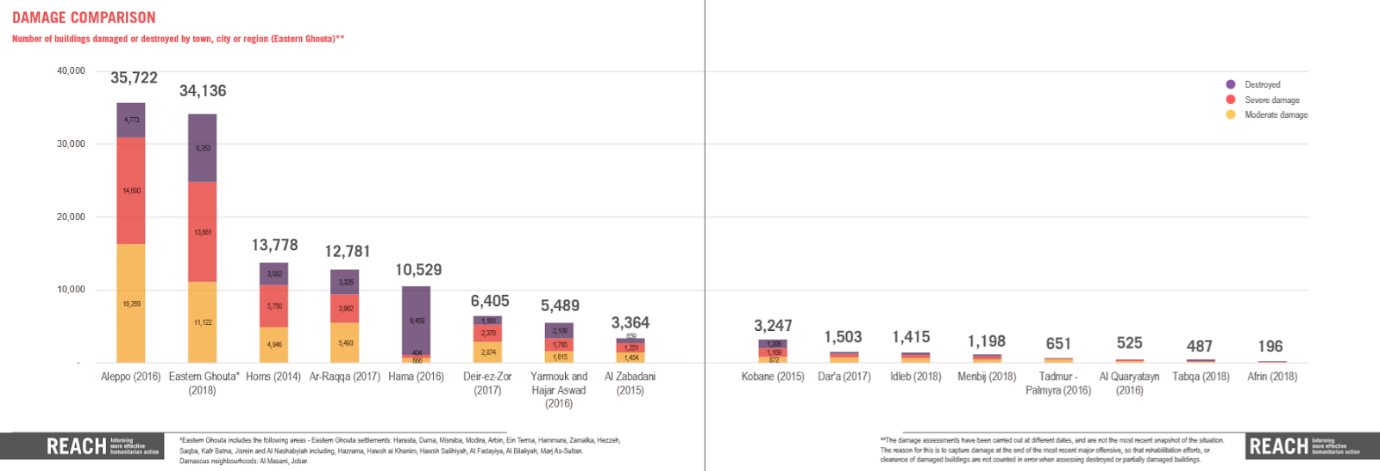| This is the third blog post in a series looking at an array of issues in 2020 related to weapons use, the arms trade and security assistance, at times offering recommendations. |
By 2017, 50% of basic social infrastructure in Syria was non-operational, mostly due to the destruction incurred during hostilities. This damage continued through 2018, including over 34,000 buildings damaged or destroyed just in Eastern Ghouta. Such harm continued across the country this year, and will do so until the conflict is brought to an end.
Estimates on the levels of rubble generated have only been carried out for Aleppo and Homs, with war damage creating 15 million and 5.3 million tons respectively. A 2019 study by REACH, a humanitarian initiative providing data from contexts of crisis, further revealed that Aleppo had almost 36,000 buildings damaged or destroyed, similar to Ghouta. Raqqa, with almost 13,000 buildings damaged or destroyed has witnessed a similar level of harm as Homs.
Combined the devastation of Syria raises serious environmental issues and health concerns, especially for those who remain or return, and those involved in clearing the destruction.
The debris poses serious health risks, exposing those in the impacted areas to hazardous material in both the air and the ground, such as toxic smokes and heavy metal. An indication of the consequences this may have on local populations might be seen from the significantly increased cancer risk for those exposed to the release of toxic dusts in the destruction of the World Trade Center in 2001; some 43,000 people have been certified with a 9/11 related health condition, including almost 10,000 with a related cancer. More recently, in Paris, there has been concern over potential lead poisoning of the residents living nearby Notre-Dame Cathedral, after the fire and destruction in April 2019.
Further environmental concerns for 2020 will be likely faced in things such as informal waste dumping and an increase in burning of waste as land is attempted to be cleared. In Lebanon, for instance, the debris left from the destruction of downtown Beirut in the civil war, which ended in 1990, contributed to the country’s lasting garbage problem, which – in turn - has led to pollution in the Mediterranean and caused significant air pollution for Beirut’s inhabitants.
A similar situation occurred in post-WWII Germany. Much of the 10 million tons of rubble taken from Nuremburg’s Old Town was deposited in an excavation pit. In the post-war years, waste continued to be dumped there. As few safety measures were carried out, leaching of this waste saw the connected Silver Lake become severely polluted, with lethal concentrations of hydrogen sulphide entering the lake. While the landfill has since been landscaped, forested and incorporated into the Volkspark Dutzendteich, the Silver Lake, or Silbersee, continues to be heavily polluted and at least fifty people have lost their lives after bathing in that lake.
Explosives among the debris
The failure rate of modern weapons is estimated to be about 10%. To give a scale of the numbers of weapons that may be lying in Syria unexploded, in just five months, the US-led coalition fired 30,000 artillery shells on Raqqa. With a 10% failure rate, this leaves about 3,000 items of unexploded ordnance (UXO) from just one party to the conflict in just one city. By 2018, at least 25,000 munitions had been dropped by the US-led coalition, while Russia declared more than 39,000 airstrikes in the first three years of fighting, and improvised explosive devices are littered across Syria’s scarred landscape. The appetite for these state actors to identify the harm their bombing campaigns have caused, let alone address this harm, is minimal.
This mountain of lethal legacy makes clearance a far deadlier task. While IEDs are likely to cause injuries, the UXO from manufactured weapons generally contains significantly higher levels of explosives and tend to result in fatalities. Those carrying out the clearance are often unprepared for the task.
When AOAV interviewed members of the Rojova Mine Control Organisation (RMCO) in 2018, they reported significant challenges to clearance efforts in Raqqa, including a lack of large and armored vehicles to clear the rubble, something necessary due to the ammunition and booby traps among the debris.
As such, as organizations and experts do not have the capacity or equipment to clear the debris, many civilians will carry on in 2020 conducting this dangerous work. An Amnesty investigation found at least 1,000 people killed by explosives between October 2017 and April 2018 in contaminated areas – with many more dying before reaching medical care, and so going unrecorded.
Overall in 2020, Syria will face a mountain of conflict debris contaminating its land, air, and water, a large proportion of this caused by the use of explosive weapons in populated areas. And it is not just Syria. Iraq, Yemen, and the Philippines are among those who have also experienced such destruction in recent years. And so, as Syrians begin to clear rubble and slowly rebuild, the safety of civilians in such clearance should be a pressing priority for humanitarian agencies. This means minimizing civilians’ exposure to toxic dust, ensuring materials are disposed of in a way that minimizes contamination of soil and water supplies, and clearing UXO. Without such measures – and fast – the Syrian conflict will continue to claim more lives.
Iain Overton is Executive Director of Action on Armed Violence (AOAV) and Forum-listed expert. Jennifer Dathan is a Researcher at AOAV.




 RSS Feed
RSS Feed